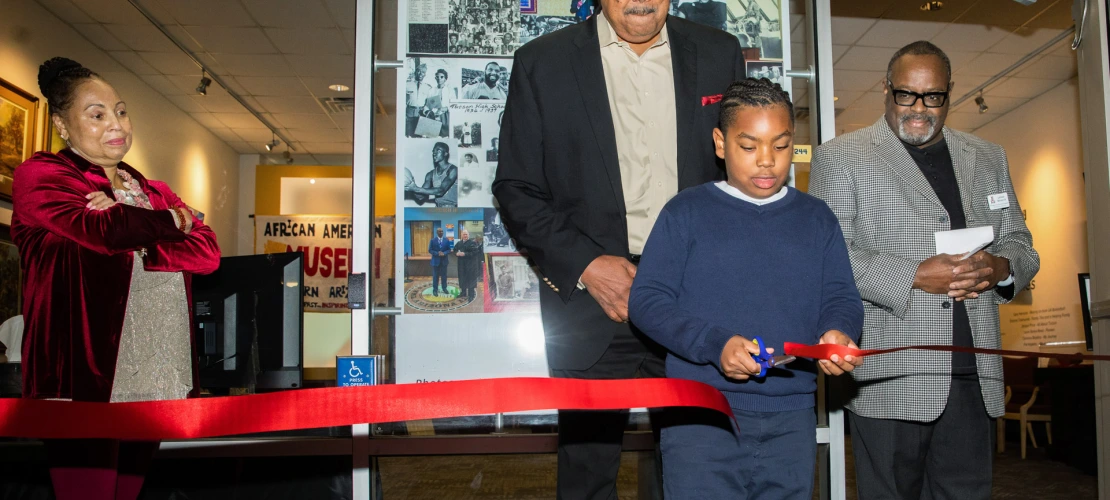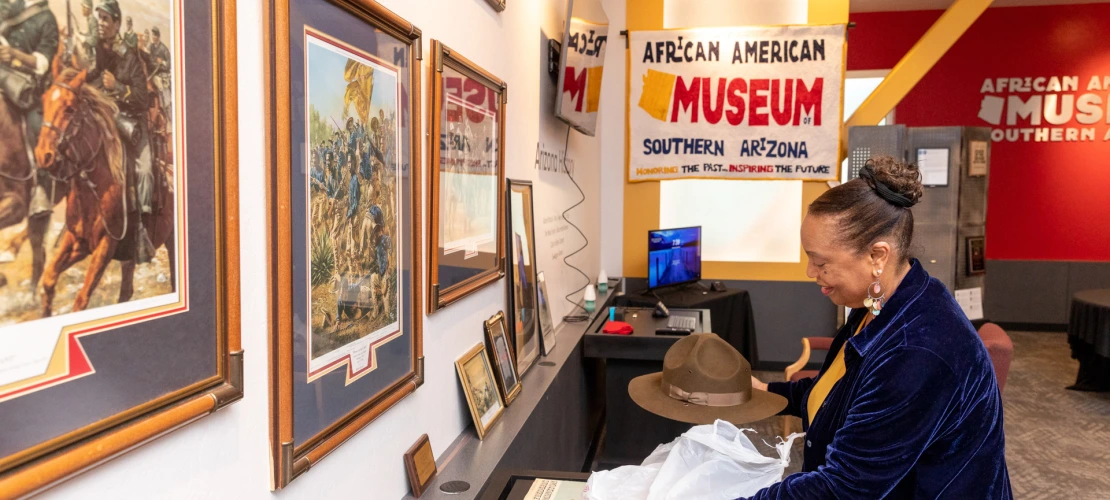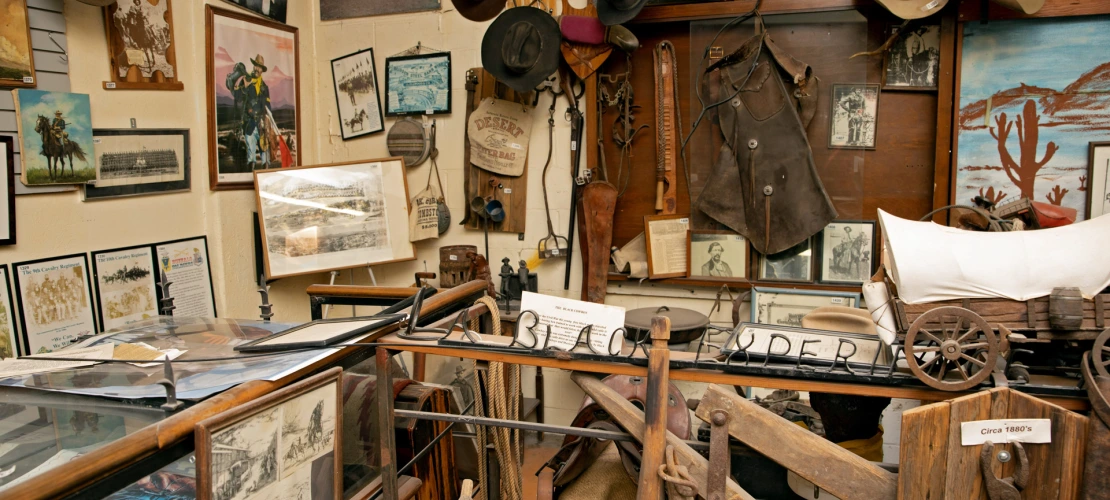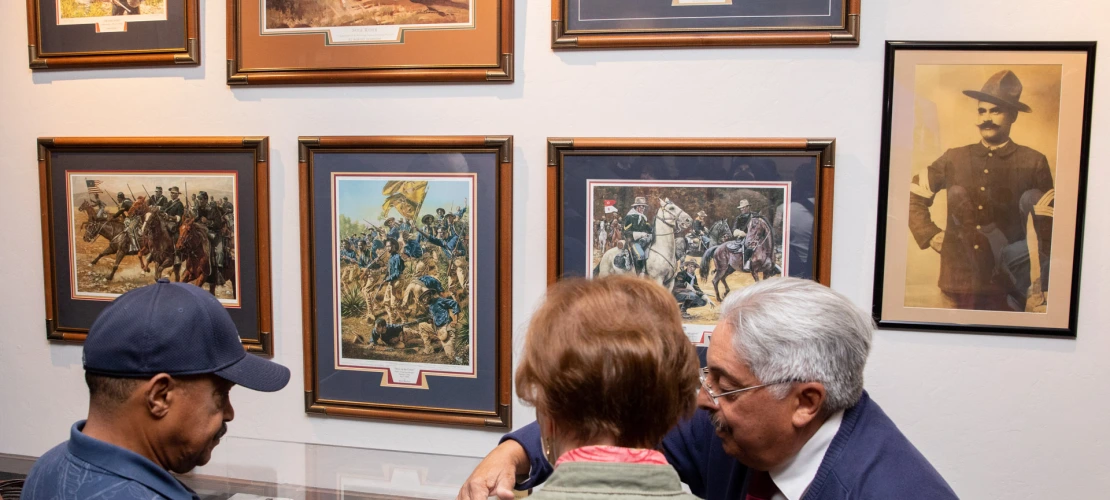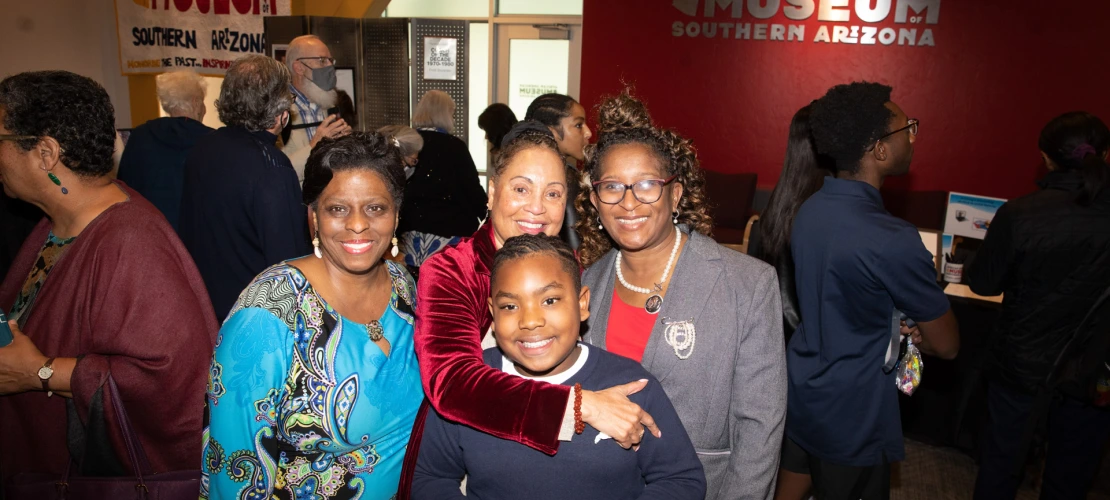Two Museums, One Cause
Kendrick and the Elliotts raise awareness of Black history in Tucson, Southern Arizona and the country.
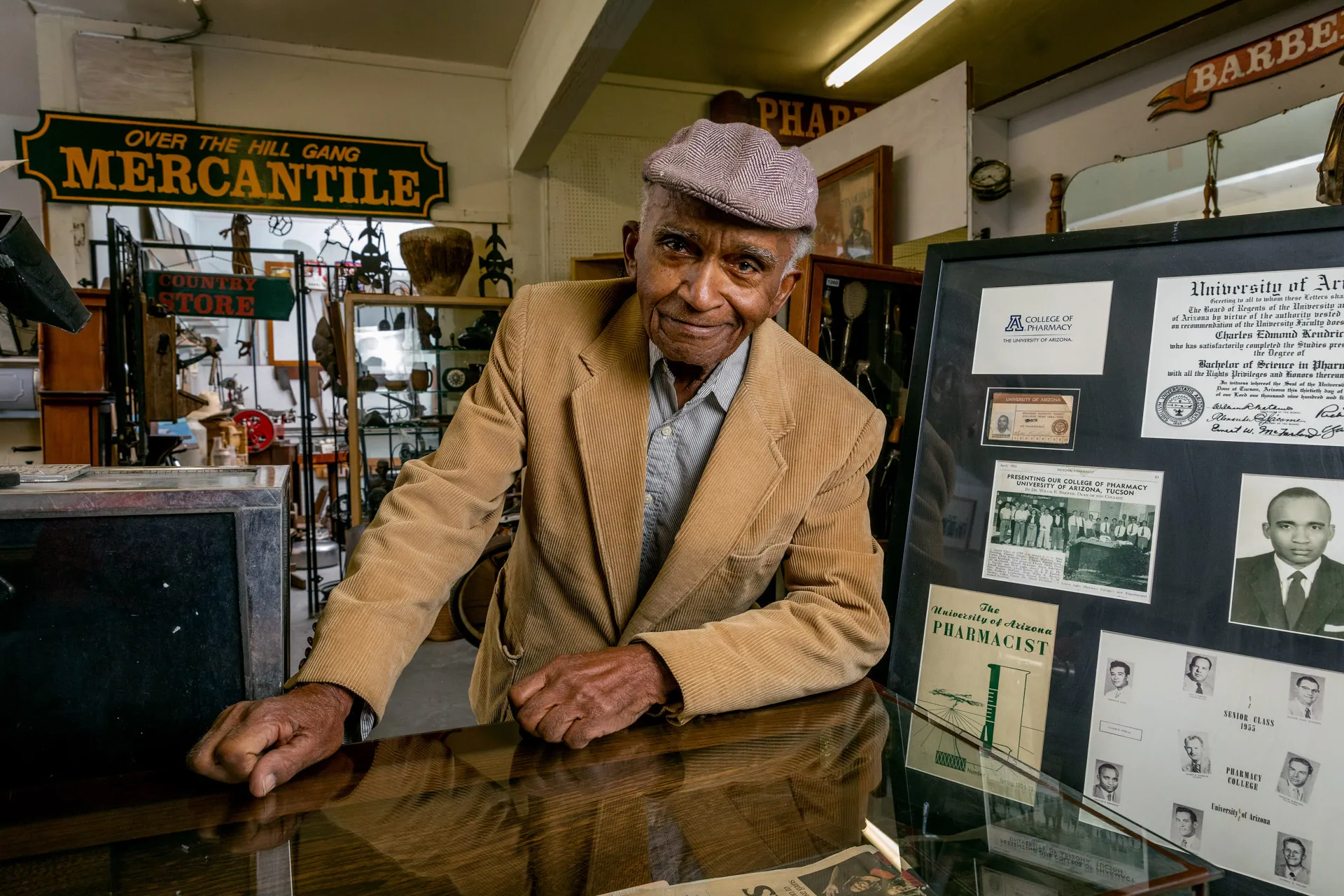
A photograph of Charles Kendrick ’55, the first Black in-state graduate of the pharmacy college
Chris Richards
When Charles Kendrick ’55 remembers his grandfather, he wonders how he made it through. A Black man who came of age in Stamps, Arkansas, after the Civil War, he raised 12 children, with his wife, on wages earned at a lumberyard and the profits from his dime-sized grocery store, which sold ice cream, popsicles and candy. The family lived in a five-bedroom house — custom built and far, Kendrick says, from a “shack.”
Later, after Kendrick’s birth, came the move to Texarkana, Texas, 30 miles west of Stamps. Kendrick’s grandparents took him and his older brother there after their mother died young of tuberculosis. Kendrick recalls seeing her only once, through the windows of a hospital he couldn’t enter because of his age. Their father, meanwhile, had departed the region altogether, making them “technically orphans.”
It was the Depression. In Texarkana, on the Texas-Arkansas border, their grandfather found employment through the Works Progress Administration, a New Deal agency introduced by President Franklin Delano Roosevelt in the years before World War II. Kendrick says that because of hiring discrimination, his grandfather’s hours were uneven. But he also says that the family never went hungry, a point of pride.
“I wish I had been able to ask him about that when I was growing up,” says Kendrick, who, at 91, has beaten both cancer and triple-bypass surgery. “I mean, that’s why I’m here, you know? Because of him having a background trying to make it.”
Kendrick remains a son of that era of impoverishment, through and through. He shined shoes before he was a proper teenager and carries his original Social Security card, received at the age of 12, in his wallet to this day. Once, he worked for H. Ross Perot at the Texarkana Stockyards, where the white kids were hired before the Black kids to contend with surly razorback hogs. The former presidential candidate, he jokes, owes him two hours’ back pay.
He keeps in his possession the cash register, doorbells and scales from his grandfather’s Stamps store, in operation from 1890 to 1930, a year before his birth. The heirlooms sit in the back of his Afro-American Heritage Museum, which Kendrick opened on Tucson’s South Park Avenue with a late friend, Shadrick Blair, in 1998.
Now shown to the public by appointment only, the city’s early Black history museum contains more than 3,000 artifacts culled by Kendrick and Blair across three decades. The collection preserves chapters of history that, Kendrick says, the nation doesn’t often see. On a wall, he’s mounted a receipt acknowledging the $1 poll tax his grandfather paid to vote while earning a quarter a day; in a display case, he’s laid out racist advertisements depicting caricatured Black bodies.
Kendrick also displays artifacts documenting the incarceration of Japanese Americans during World War II. “America hasn’t been a beautiful place to everybody,” he says. “To some it has. To a heck of a lot, it hasn’t been. And nobody wants to face the truth about what happened.”
Yet the self-funded museum also features an upholstered barber’s chair, representative of the barbershop’s role as a meeting ground in the Black community; detailed recreations of both classroom and drugstore, harkening back to Kendrick’s long career in medicine; and his framed University of Arizona diploma, from an era when the campus welcomed few Black students.
Kendrick, then, is setting the record straight about history, both the difficult and the inspiring. And today, his daughter, Rhonda Moniz, sustains his legacy. She’s working on the museum’s next stage — as a cultural and community jewel, rechristened the Tucson Center for Black Life (TCBL) and holding tax-exempt, federal nonprofit status. The TCBL will serve a dual purpose: It will be both museum and community center, in the neighborhood, South Park, where her father and other Black Tucsonans forged sturdy bonds.
Plans for the TCBL’s first exhibits, Moniz says, should be in place by Juneteenth 2023.
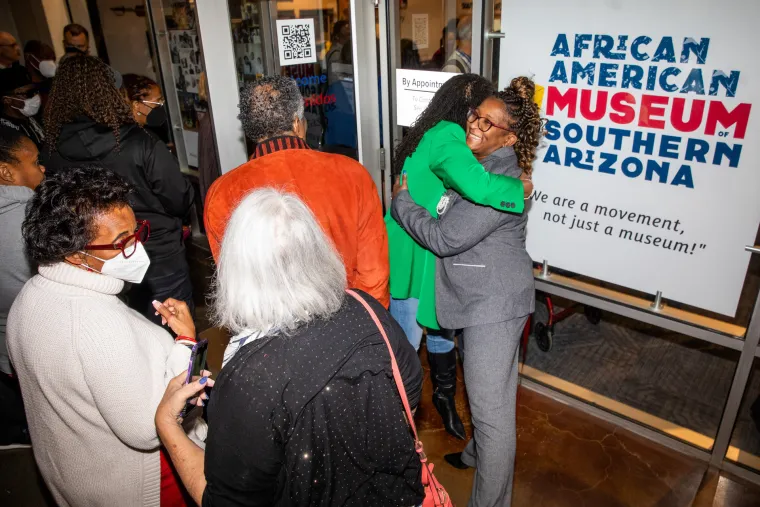
The celebratory opening of the African American Museum of Southern Arizona
Chris Richards
BUILDING A LIFE — AND A BLACK HISTORY MUSEUM — IN TUCSON
Kendrick’s brother left Texarkana after high school, heading to California. Kendrick thought he’d do the same but ended up in Tucson, at age 16, after hearing that his father was in town, working in maintenance at UArizona. By then, Kendrick had determined his career path — he’d be a pharmacist. In the South, such programs weren’t yet integrated; at UArizona, select Black students could study.
Kendrick’s college experience was decidedly mixed. He calls his first day “the darkest of my life.” In the Old Main cafeteria, he was refused service because of his skin color. When he asked for a tuition reduction, his father being an employee of the school, he was told janitors didn’t count. The director of the Air Force’s ROTC program also barred him.
“You live through those things. It’s not pleasant. You never forget them,” he says. “But it happened. It was the American system at the time.”
Kendrick persevered, becoming the first Black in-state graduate of the pharmacy college. He lists positives from his time on campus: Because of his degree, he’s never faced unemployment. He became friends with other Black students; they’d gather in a barbershop to trade news. The Army’s ROTC program welcomed him, such that he received a commission as an officer. And he’s a fan of Arizona Athletics, though never himself a jock.
Kendrick’s dream was to own and operate a drugstore. He got together the money for the building where his museum now stands for that purpose. But no bank would loan him the funds to start the business, an experience that he says has been common within the Black community nationwide.
Instead, Kendrick worked at Pima County Hospital — today, Banner – University Medical Center South — for 42 years, including 18 as the outpatient pharmacy supervisor. During a first, restless attempt at retirement, he and Blair founded the museum. He ran a barbecue restaurant, Mr. K’s, in the same building — the museum in one half, the restaurant in the other, cash from the second supporting the first. Today, the restaurant has relocated, and his son, Ray, runs the enterprise under the name Original Mr. K’s BBQ. In 2006, the family business’s ribs recipe was listed among the country’s best by Nancy Davidson, a food and travel writer, in her book “Killer Ribs.”
These days, Kendrick mostly paints, focusing on the Great Depression, Tucson and the Civil War, though he also shows the museum to interested groups — students, for instance, or aspiring police officers in sensitivity training. And he displays his art alongside the rest of his trove, a testament to history and to accumulated experience.
As he prepares to “ride off into the sunset, not in a blaze of glory but quietly,” Kendrick concludes that his journey has been about taking care of what he “had to do” to build a meaningful life.
The TCBL, of course, will outlast him.
“I hope to see my collection reimagined in a way that honors our history, draws attention to the contributions of African Americans and continues to give back to the community,” he says.
THE NEW AFRICAN AMERICAN HISTORY MUSEUM IN TOWN
Kendrick’s museum, of course, has never been the only repository of Black history in Tucson, however thorough his and Blair’s collection of artifacts. Count, too, the Dunbar Pavilion, an arts and culture center once home to the segregated Dunbar school, and the city’s Black churches.
And, as of January, the African American Museum of Southern Arizona (AAMSAZ), established in Suite 244 of the UArizona Student Union Memorial Center by Executive Director Beverely Elliott ’88 and her husband, Bob Elliott ’77 ’84, who played basketball at Arizona and in the NBA and today is president of Elliott Accounting.

Beverely and Bob Elliott
Chris Richards
Beverely Elliott, a retired educator, says that AAMSAZ began when the couple’s then-7-year-old grandson, Jody, asked where he could learn about African American history in Tucson for a school project. They didn’t know what to say. At the time, no African American museum in town — or elsewhere in the state — held federal nonprofit status and was regularly open to the public.
AAMSAZ has started fast. In November 2022, the museum hosted, in a packed auditorium at Palo Verde High School, a fireside chat with Ruby Bridges, the civil rights legend who, as a 6-year-old, integrated New Orleans public schools despite community resistance. In February, at the Loft Cinema, the museum held a conversation with Stacey Snowden. At UArizona in 1972, Snowden’s father, Fred, became the first Black men’s basketball coach at a major college or university, as well as the second African American to lead an NCAA Division I men’s basketball program. The museum also features a robust digital archive of oral histories celebrating pioneering African American Tucsonans, including Kendrick.
“We want to be a lot more than just a museum. We are a movement,” Beverely Elliott says. “Museums have to change. They can’t just be places where you walk up to a little placard and you’ve got to read what you’re looking at up on the wall.”
Bryan Carter, an associate professor of Africana studies at UArizona whose long-term Virtual Harlem project has immersed students and researchers in the world of the Harlem Renaissance, applauds the Elliotts’ attention to the personal and individual stories of Black life. Carter, who also directs the Center for Digital Humanities on campus, says that the oral histories and legacy stories at AAMSAZ remind him of the Smithsonian’s National Museum of African American History and Culture in Washington, D.C.
“Those little-known stories about African American history that are either marginalized or eliminated or just never told are important to be exposed in a museum setting like this,” he says. “Because those stories are just as important as the ones from huge civil rights leaders.”
AAMSAZ’s exhibits will rotate. Among them is a digitized collection documenting the Buffalo Soldiers, the Black U.S. Army servicemembers stationed in the Southwest following the Civil War. There is space dedicated to Snowden, too, and to the CROWN Act, a law prohibiting discrimination on the basis of hair style and texture that, Beverely Elliott says, has not been passed in Arizona. And there is a slave-code quilt that, through the symbols in its colorful fabric, would’ve directed runaway slaves to safehouses on the Underground Railroad.
Beverely Elliott says that AAMSAZ will affirm African American presence in Southern Arizona and in the United States at large. She notes that while Tucson is today estimated to be just 4% Black by the U.S. Census Bureau, the number was much higher in 1870, about 20%. Bob Elliott, for his part, says that UArizona’s African American community must see such history to feel connected to the place where they work and live.
“A short-term goal for AAMSAZ is that the university will be able to utilize the museum to help with the recruitment and retention of African American students, faculty and staff,” he says.
But the Elliotts are taking the long view with AAMSAZ, too. Just like Kendrick, they won’t let legacies of African American resilience be lost to time.
“African American history is American history, and we just want to be included,” Beverely Elliott says.
“We’re all a part of this country, and we want to make sure that people understand that Southern Arizona had African Americans, and we made an impact.”
The museum’s January opening, held the Saturday before Martin Luther King Jr. Day, drew an estimated 360 attendees. Jody performed the ribbon-cutting following remarks from Bob Elliott and Lehman Benson, UArizona vice president of Black advancement and engagement, who spoke on behalf of President Robert C. Robbins.
“We thought there would be maybe 50, 60 people over two hours. I mean, the capacity is 71,” Beverely Elliott said that day. “This is a lot more than what we ever could have dreamed of. There’s no way we thought it was going to be like this.”

